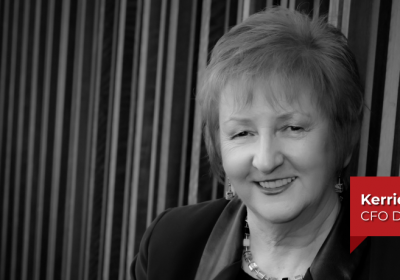
- Author: Bronywyn Wilkie
- Posted: March 25, 2025
Stephen Xiao > The CFO Behind Australia’s $360M Hidden Digital Giant
New Aim is Australia’s largest private e-commerce player, but it thrives in the shadows, powering thousands of online businesses with its digital-first, AI-driven approach to retail.
However, despite its massive reach, the company remains largely unknown to everyday consumers.
As CFO Stephen Xiao puts it: “Our products are in over 60% of Australian households. Every year, we ship around 4 million parcels. But if you ask the average consumer who we are, they wouldn’t have a clue.”
What started as a single eBay store in 2005 has evolved into a $360 million revenue machine, operating across multiple marketplaces, enabling retailers, and even developing its own AI tools.
And according to Xiao, the company is just getting started.
Scaling Smarter: How New Aim Grows Without the Burn
Xiao’s current focus is on building a scalable, high-efficiency business—one that runs on AI, automation, and digital infrastructure rather than excessive spending. The goal is to expand profitably while staying agile enough to outmanoeuvre larger competitors.
“We invest heavily in technology every year,” Xiao explains. “Our digital supply chain is our backbone—it covers everything from product selection to international freight, warehousing, courier integration, channel distribution, and after-sale customer services.
“It’s not just about selling products: it’s about building a seamless, AI-powered ecosystem that makes e-commerce easier and more profitable for our partners.”
That efficiency has made New Aim a top seller on every major Australian marketplace—from Myer and Woolworths to Amazon and eBay. When large retailers made their inevitable pivot online, New Aim was already there, ready to supply the products they needed to fill their digital shelves.
“The key is to stay ahead of the curve and what’s happening in the market,” says Xiao. “We were one of the first sellers on eBay, then we pioneered dropshipping in Australia, then we built a B2B2C marketplace to enable more businesses. Now, we’re leveraging AI to drive even bigger efficiencies.”
Why AI is this CFO’s Secret Weapon
For Xiao, AI is already transforming the way New Aim operates.
Take order fulfillment, for example. Instead of relying on manual decision-making, New Aim’s AI analyses thousands of data points, including which products customers tend to buy together, warehouse layout, package dimensions, and the performance of different couriers in specific postcodes. It then streamlines everything from shelf placement to last-mile delivery.
“AI helps us reduce costs and improve service at the same time,” Xiao says. “For instance, our system can automatically assign the best courier for a package—not just based on price, but on historical service quality in a given area. That means fewer delays, fewer lost parcels, and better customer satisfaction.”
AI’s impact is reshaping finance, too. By automating payments, syncing operational data in real-time, and embedding anti-fraud software into transactions, Xiao’s team has dramatically increased efficiency.
“In a lot of businesses, month-end reconciliation can take 10, 15, or even 20 days,” he says. “It now takes us just three working days—and it’s more accurate. That’s real transformation.”
New Aim has also developed its own AI tool, AirOxy, in partnership with Google. Designed to support smaller retailers, AirOxy provides AI-driven insights on pricing, content creation, and big-data analytics, helping e-commerce businesses make smarter decisions.
“AI allows us to scale without adding headcount,” says Xiao. “It’s not about replacing people—it’s about enhancing what we do, automating the repetitive, and letting humans focus on strategy.”
The Future of Retail: From Storefronts to Digital Ecosystems
While brick-and-mortar retailers have struggled to keep pace with e-commerce giants, Xiao doesn’t believe physical retail is dead. But he does think it needs to evolve.
“The future of retail isn’t just online or offline—it’s both,” he explains. “We’re already seeing this in markets like China and the US, where traditional stores are transforming into experience hubs rather than just transaction points.”
Instead of stocking full inventories in-store, brands are using physical locations as interactive spaces, where customers can see, touch, and test products before making their transactions online.
For New Aim, this shift presents an enormous opportunity.
“With our factory-to-front-door model, on the one hand, we are empowering overseas manufacturers with our digital supply chain services for them to tap into Australian market. On the other hand, we’re enabling Australian retailers to operate with minimal overheads—so there’s no need for large warehouses, no need for massive inventory investments,” Xiao says. “We’re making it easier than ever to run a retail business online.”
What’s Next for New Aim?
Looking ahead, Xiao sees two major areas of growth for New Aim.
The first is “borderless e-commerce”, with the company expanding its B2B2C marketplace to bring overseas suppliers directly to Australian customers, while also eventually helping Aussie businesses expand internationally.
The second involves commercialising New Aim’s technology by offering its digital infrastructure, AI tools, and supply chain capabilities as services to external retailers.
“We’ve spent years perfecting our own e-commerce systems,” Xiao says. “Now, we’re opening them up so other businesses can leverage what we’ve built.”
As for his role as CFO? Xiao sees it as more than just managing financials—it’s about using technology and data to drive business strategy.
“The CFO’s role isn’t just about numbers anymore—it’s about building smarter systems, leveraging data, and creating value beyond the balance sheet,” he says. “If you’re just managing financials, you’re already behind.”
If New Aim’s rapid growth and operational efficiency are any indication, Xiao’s approach is already paying off. And as the retail sector continues to evolve, this “invisible e-commerce giant” looks poised to play an even bigger role in shaping its future.
A future where Xiao will, of course, continue to stay ahead of the curve.
Stephen Xiao’s Key CFO Advice
Leverage AI to drive efficiency
“I tell my team: embrace AI, embrace automation. There’s no reason why finance functions should still be bogged down by manual processes. The more we automate, the leaner, faster, and more strategic we become.”
Growth doesn’t have to mean burn
“You can expand without excessive spending. Smart automation, digital infrastructure, and data-driven decision-making allow for sustainable scaling.”
Retail’s future is hybrid – be ready
“Brick-and-mortar isn’t dead, but it’s changing. The most successful retailers will seamlessly integrate online and offline experiences.”








